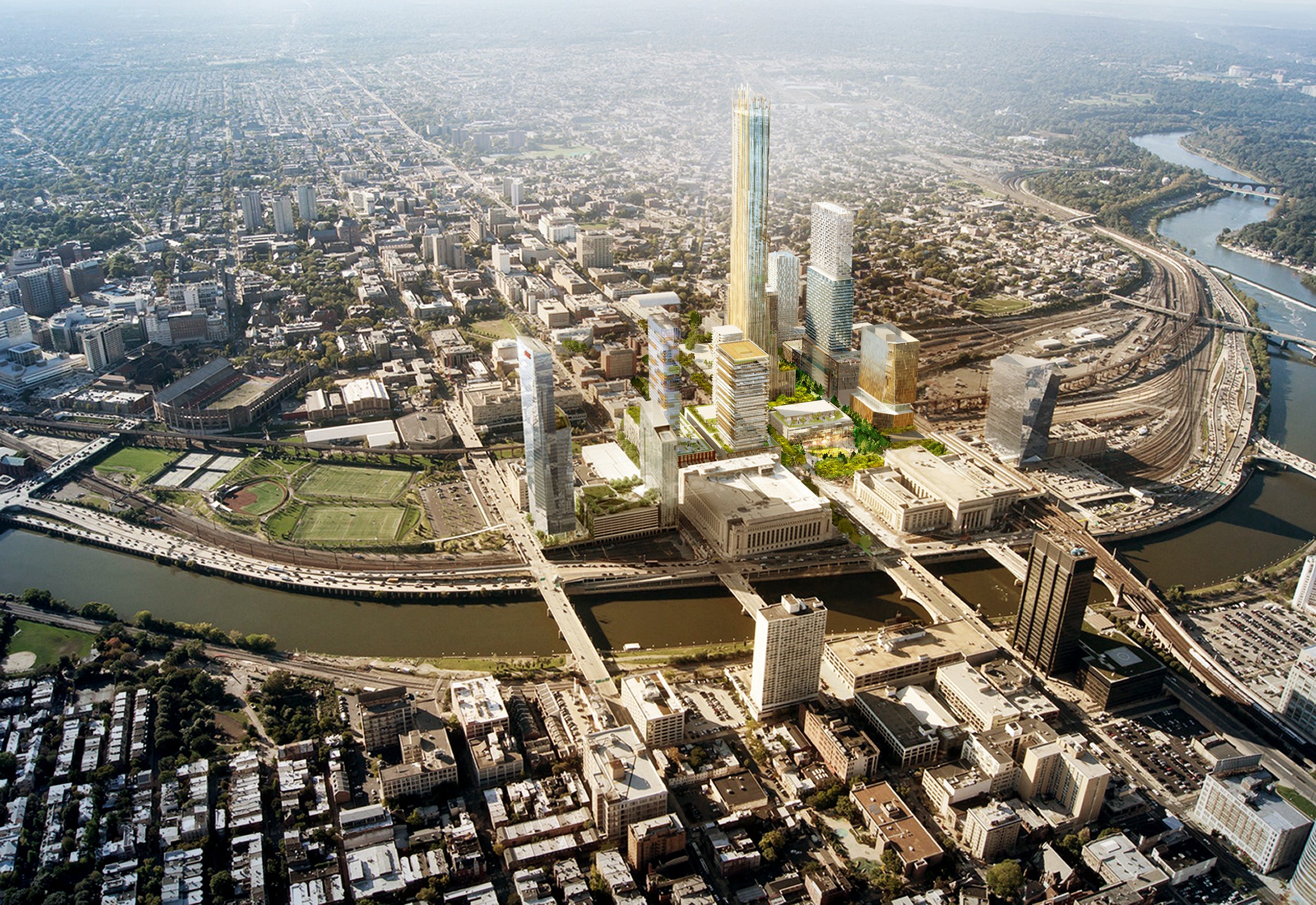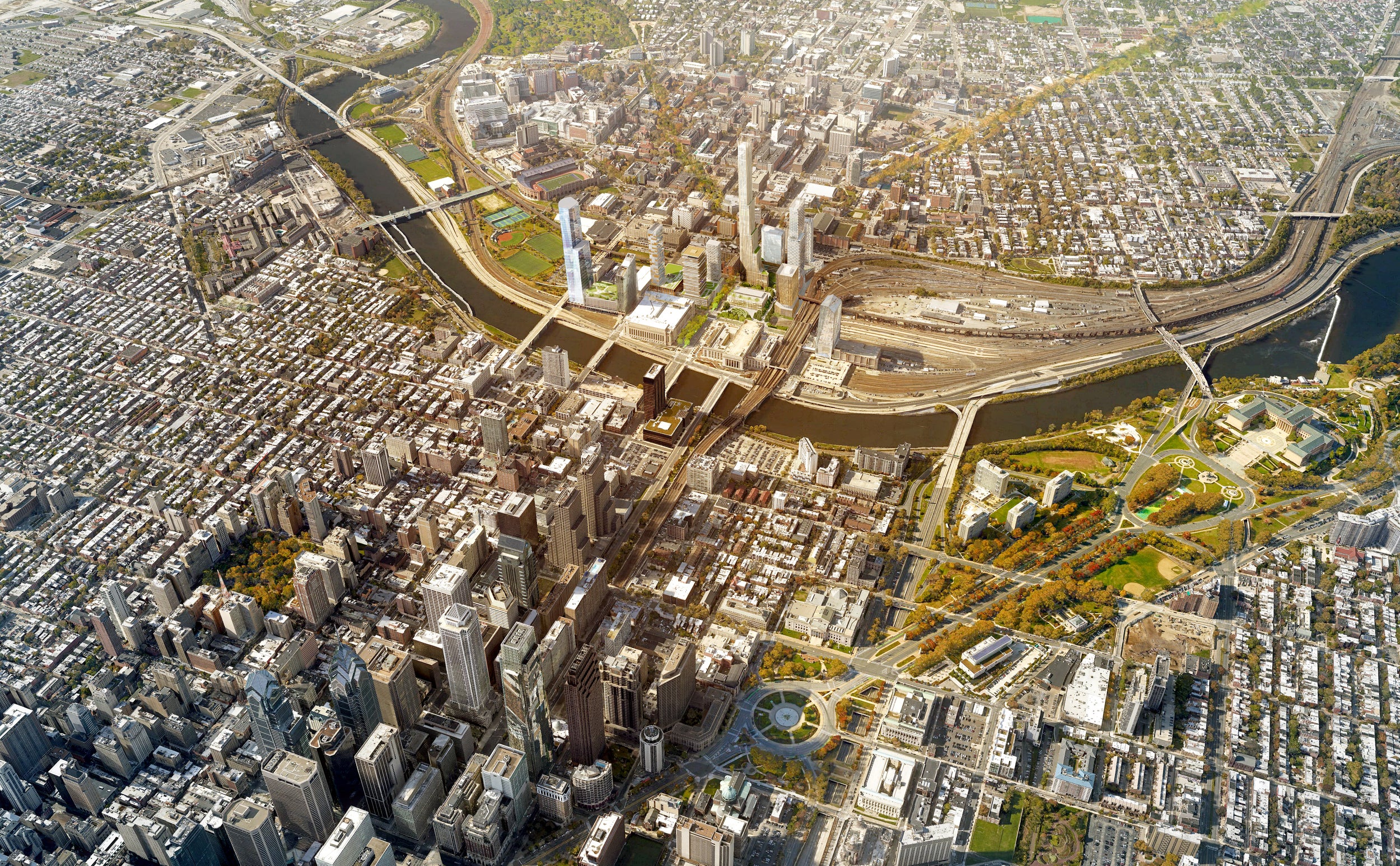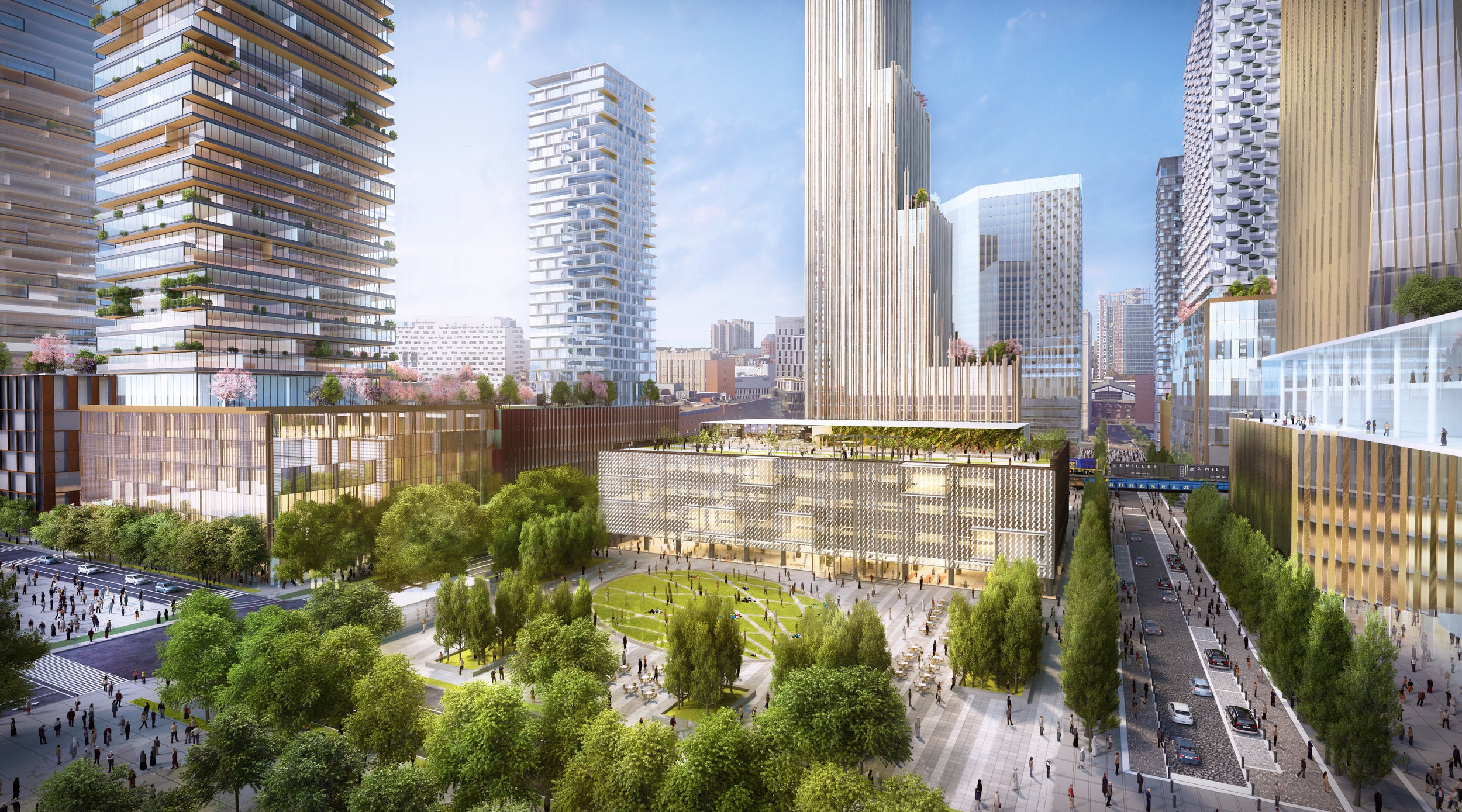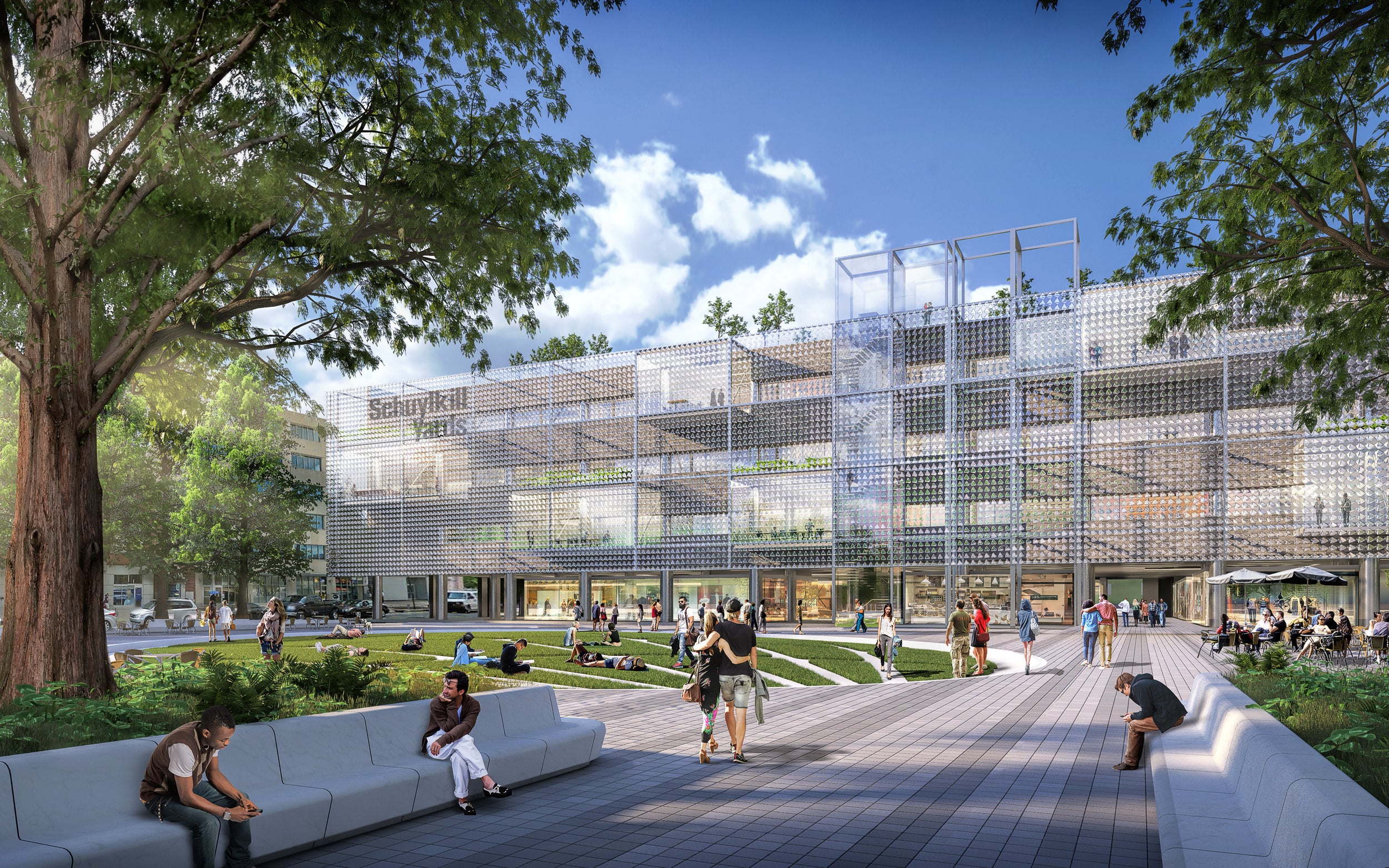With new Schuylkill Yards, Drexel and Brandywine promise development without displacement

Standing before a room packed with Philadelphia’s preeminent businessmen, power lawyers, labor leaders, and politicians, Drexel University President John Fry unveiled Schuylkill Yards, a 14-acre, $3.5 billion plan to create a new neighborhood out of whole cloth. Philadelphia has not seen a proposal this ambitious or consequential since the 1950s, when Ed Bacon and Joe Clark tore down the Chinese Wall to create Penn Center, which moved the city’s commercial downtown west of City Hall. Schuylkill Yards promises to move downtown again, this time west of its eponymous river.
The breathless buzz about Schuylkill Yards’ heralded skyscrapers and ‘innovation neighborhood’ have dominated the headlines so far. But Fry made a promise bolder and more ambitious than a mere multibillion-dollar real estate deal.
Speaking specifically about nearby Mantua and West Powelton, Fry pledged: “This 20-year, $3.5 billion project will benefit thousands of low-income families without disrupting the fabric of their neighborhoods.”
Without disrupting the fabric of their neighborhoods.
Schuylkill Yards isn’t just a big development deal; It’s a social experiment deliberately designed to thwart displacement and the negative consequences of gentrification. And if it works, John Fry and his team will solve one of the most confounding—and contentious—problems affecting cities today.
They’ll gentrify a neighborhood without displacing its community.
BRANDYWINE BETS BILLIONS ON UNIVERSITY CITY
Drexel’s primary partner in realizing the Schuylkill Yards dream is Brandywine Realty Trust, led by Jerry Sweeney. Drexel is giving Brandywine a 99-year lease over the ten acres it owns outright (another four are split among various owners, most notably CSX and its freight rail highline).
Brandywine is the obvious developer choice for Schuylkill Yards. The company has already invested heavily in the area, with buildings like Cira Centre and Evo reshaping University City’s eastern edge.
Drexel and Brandywine are also partnering on the even more ambitious 30th Street Station District plan, which envisions capping the station’s rail yard one day. Capping even a fraction of rail yard’s 175 acres would cost billions, more than Drexel, SEPTA, Amtrak or the City of Philadelphia could ever dream of spending. To justify its astronomical expense, the cap would have to support incredibly valuable real estate.
Today, the triangular rail yards are bordered by the river on one side, Mantua—a community with poverty so persistent the federal government designated it a Promise Zone in 2014—on the other side, and what will become the Schuylkill Yards on the third. Both Sweeney and Fry told PlanPhilly that Schuylkill Yards is the first step in proving to investors that a capped rail yard could make economic sense.
“I think [Schuylkill Yards] gives us the opportunity to make the case for why, eventually, the success here should be replicated over there,” said Fry.
Fry acknowledged that Schuylkill Yards would increase property values, a prerequisite to raising the investment capital necessary for building over the rail yards thirty years from now. “In a way, this whole thing leads naturally to that happening,” said Fry.
“[Capping the rail yards] can’t happen without this being successful. That would be too big a risk to try by itself. But if we have twenty years of progress in this area, I think it will presage something that can happen there.”
Increasing property values presages something else for residents in nearby Powelton, Belmont, and Mantua, though: gentrification and displacement.
CAN DREXEL SOLVE GENTRIFICATION?
Gentrification is a storm cloud of a term, nebulous and highly charged. How you construe gentrification often says more about you than it does the concept.
Detractors and supporters alike usually agree that gentrification describes when an area experiences relatively rapid development—construction of new homes, renovation of old ones, and a burst of new amenities catering to newer residents. Appurtenant to the building comes an influx of new residents.
Less agreed upon is how much those newcomers involuntarily displace the preexisting population, versus how much neighborhood change is simply visible. Increased demand can raise property values, which leads to higher rents and property taxes. That, in turn, can force lower-income renters and homeowners out of the newly improved neighborhood, one they may have lived in for decades.
Just how much displacement happens (compared to non-gentrifying neighborhoods), and how much the remaining residents benefit from gentrification, remains contentious. Race’s role in gentrification is even more controversial—while some research suggests that wealthier whites gentrifying poorer African-American neighborhoods is relatively rare, the racial contrast makes those instances so much more dramatic.
Just consider the neighborhood surrounding the Sadie Alexander School: After Penn built the K-8 school in 2001, property values in its catchment area doubled, and the African-American population declined 52 percent.
THIS TIME WILL BE DIFFERENT…
During his years as Penn’s Executive Vice President, Fry was a driving force behind its West Philadelphia Initiative, responsible for projects like the Alexander School. And Fry says he’s learned from that experience.
Penn moved to stabilize the neighborhoods west of campus following a string of violent crimes, punctuated by the senseless murder of Vladmir Sled, a Penn biochemist, in 1996. What followed was the Alexander School, housing credits for Penn faculty and staff to live near campus, new lighting, investments in retail to revive moribund streets, and the creation of the University City District.
It worked, better than imagined, but no one had thought about how to handle the side-effects of “Penntrification”. All the improvements made University City suddenly one of the city’s most desirable neighborhoods.
It was the Black Bottom all over again, only more subtle. In the late 50’s and early 60’s, Penn and Drexel bulldozed the predominately black neighborhood to make way for campus expansions, the University City Science Center and University City High School. Occupied buildings and residences were seized through eminent domain.
Fry says this time will be different. First off, there’s no one to displace: Schuylkill Yards isn’t a neighborhood, yet. It’s mainly a parking lot and some Drexel offices. Mantua and West Powelton are separated from Schuylkill Yards by the rail lines and by a handful of Drexel buildings, mainly dorms.
More than that, though, Drexel and Brandywine are thinking ahead about how to ensure that local communities partake in the development’s economic opportunities.
“How do we connect and partner with these neighborhoods, so that people living in those neighborhoods are actually directly taking part in the growth and development of the this area and, in turn, benefitting?” Fry asked.
The question isn’t rhetorical — Drexel is still figuring it out. In their speeches last week and in an Inquirer op-ed, Fry and Sweeney outlined broad, vague plans to hire locally and invest in the community, but few details. Mantua is a federal Promise Zone, meaning businesses receive tax breaks for hiring residents there.
Drexel is working with the Brookings Institution on developing the innovation district — creating a space where research from the nearby colleges and hospitals can turn into new business opportunities. Brookings’ Bruce Katz, who has studied these urban economic engines elsewhere, said creating an innovation district focused on inclusion was a first.
“From the starting point, there is a commitment to neighborhood regeneration, affordable housing, ensuring that market forces don’t just sweep over communities, which are literally a walk or a bike away,” said Katz. “That what’s different about this project than many of the others I’ve seen in other I’ve seen in other parts of the US.”
Katz said there were many mechanisms to consider, something echoed by Drexel’s Vice Provost of University and Community Partnerships Lucy Kerman, who mentioned Drexel’s own local school partnerships to Technical.ly Philly. By educating students from the nearby neighborhoods early on, Drexel can ensure they’re ready to attend schools like itself and Penn, and then get high-tech jobs in Schuylkill Yards’ shimmering new skyscrapers.
As a first step, Brandywine has committed to building a 1.3-acre park, Drexel Square, where a dull plaza now sits between 30th Street Station and the old Bulletin building. Sweeney said they hope to break ground before year’s end. Across JFK Boulevard—which the team hopes to recreate as a tree-lined esplanade, the first Dutch-style woonerf, or shared street, in Philadelphia—Brandywine has tentative plans for building a new tower sometime in 2018.
After that, nothing is set in stone. What gets built will be “what the market can bear,” said Sweeney. Brandywine and Drexel want a mix of retail, residential, commercial, even light industrial (think 3-D printing), but like the beautiful renderings, these are aspirational still.
Therein lies the project’s tension: a market-oriented innovation district built from scratch, held to goals for equity and inclusion.
In an interview after the unveiling, Fry admitted that they didn’t have all the answers yet. But, Fry added, ensuring inclusive economic growth and improving the neighboring community without displacement is “the whole point” of Schuylkill Yards.
“You gotta try, right? We gotta try. I mean, the more we spend time in Mantua and West Powelton and Belmont… the more we realize that this is a really important key to their success,” said Fry. “So how can I not confront that issue? Even if I’m not successful. I’m still going after this.”
FRY: BACON, AGAIN?
So far, Fry has received universal praise in the press for his ambitions. So did Ed Bacon, who ended up gracing the covers of Life and Time as the “Father of Modern Philadelphia.”
In addition to Penn Center, Bacon also left an indelible mark on Society Hill, Market East, Independence Mall and Penn’s Landing.
But reality never quite matched Bacon’s vision. Once built, Penn Center’s monolithic boxes sat cold and empty after business hours and Society Hill’s faint echoes of colonial manses during. Independence Mall’s endless stretches of enervating lawn sucked life from the surrounding neighborhoods as effectively as I-95 kept life from ever reaching Penn’s Landing. Bacon planned smarter, cared greater, and dreamed bigger than his peers, and yet he still fell short. His legacy is decidedly mixed.
What will we say about John Fry fifty years from now?
If nothing else, we will say that he tried.
WHYY is your source for fact-based, in-depth journalism and information. As a nonprofit organization, we rely on financial support from readers like you. Please give today.









